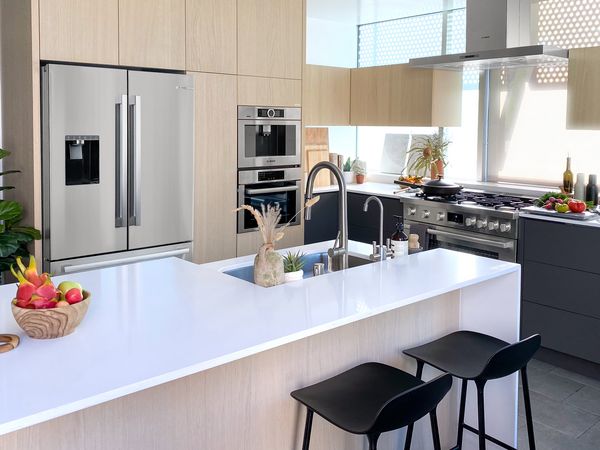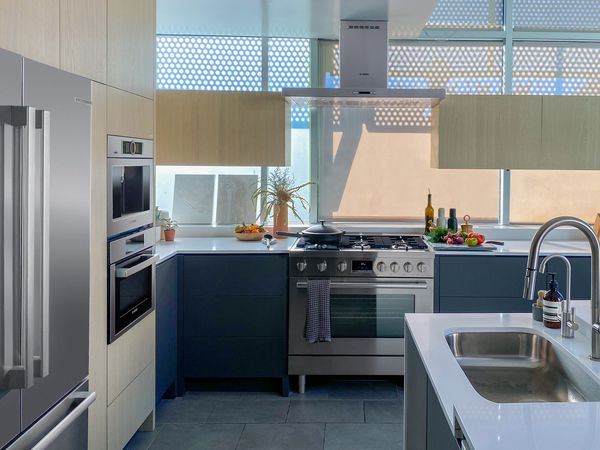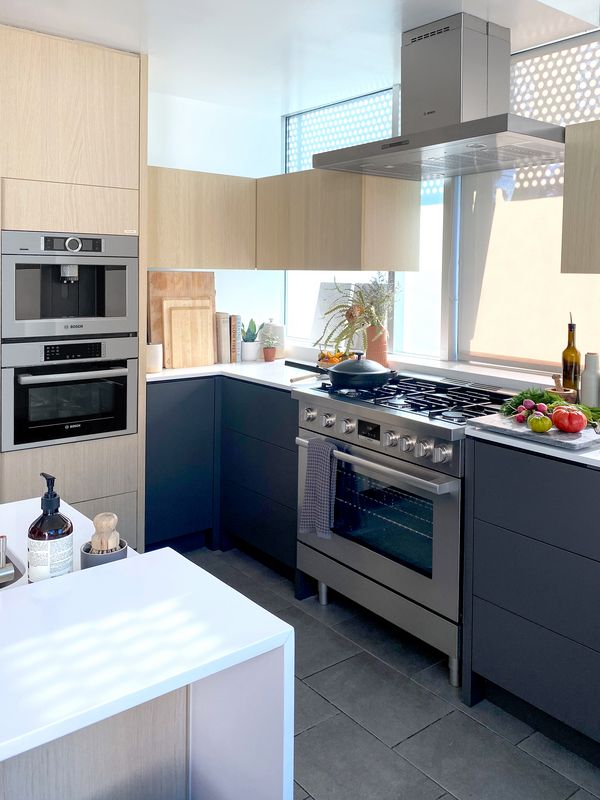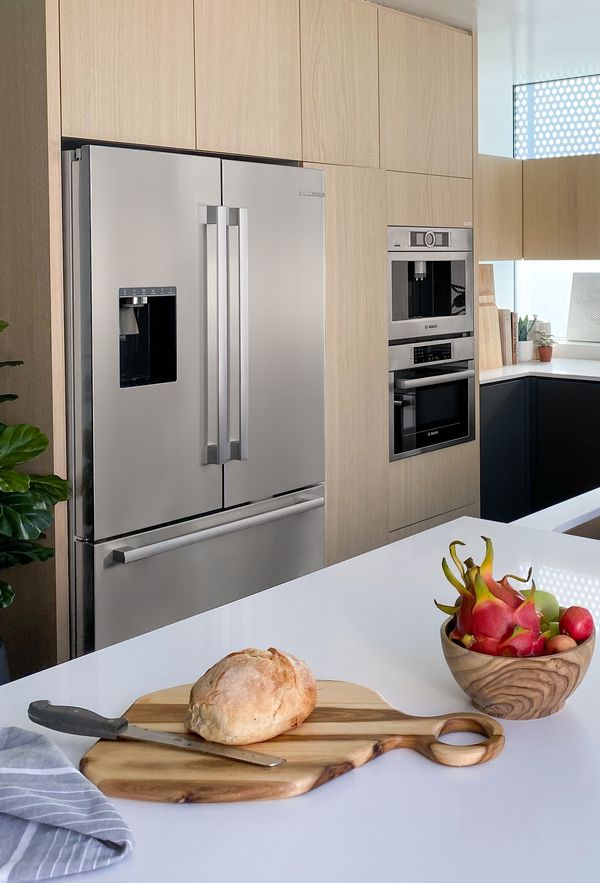A Q&A with a Designer and their Client

The renowned writer and businessman Stephen Covey once wrote, “To begin with the end in mind means to start with a clear understanding of your destination. It means to know where you’re going… so that the steps you take are always in the right direction.”
Covey’s principle of “beginning with the end in mind” is one of the most important ingredients for a successful kitchen remodel. Before undertaking a remodel, it is vital to start with a clear vision of what you want to achieve with the space. Start by asking yourself: How do you envision the space being used? What feeling would you like people to have when they walk into the space? What features are most important to your design vision?
To explore these questions and top considerations when remodeling, Bosch sat down with Valerie and Danny, who recently undertook a full kitchen remodel. Valerie is CEO and Chief Creative Officer at The Woo*, a female-led creative agency and digital marketing powerhouse with global clients across a multitude of industries. Danny is President and CEO of Utopia Development, a design-build general contracting firm, and has over 35 years of leadership experience within the construction industry. Valerie selected Danny and Utopia Development to lead the design of this project to make her vision for a sleek, modern, and minimalistic kitchen a reality.
Join us as we talk with Valerie and Danny about their kitchen remodel journey and discover design tips and tricks along the way.
Bosch: So first, tell us more about what wasn’t working in your previous space and why you decided to upgrade your kitchen?
Valerie: The previous kitchen was a little antiquated, and just wasn’t an inspiring space. I work in a creative industry, and as a creative person I think gravitated to a design that felt more modern and contemporary. At the same time, I wanted the space to feel warm and inviting, as the kitchen is truly the heart of the home. It was important to design a space that was conducive to both of these needs.
Logistically, how the previous kitchen was set up, if you had multiple people in the kitchen at once, the space became difficult to navigate. There was a counter that blocked off the sink and refrigerator area, which created this pocket where people would get corralled. Danny had the brilliant idea of removing that counter, which allowed for more freedom of movement, and that was a gamechanger.
Danny: What we try to do for clients is take what their needs are, what the challenges are of a space, take all the elements — function, form, and design —and incorporate these elements into building a great space. Valerie came to us with the goal of wanting to make an older kitchen feel more like home, which was challenging as the kitchen was built around two walls of floor-to-ceiling glass. We also wanted to change the structure and open up the kitchen so that everyone could easily move around. A kitchen is a place where people naturally congregate, so the design should reflect that openness.

Bosch: What was the design vision before you got started? Were there any factors to consider?
Valerie: I wanted the kitchen to be more modern with charcoal grey cabinetry, as my personal aesthetic is on the minimalistic side, but still to create a warm atmosphere. Danny had the foresight to also incorporate natural wood and warm undertones with the grey palette, so that it wasn’t too industrial-looking. When you design a kitchen, there’s this play of design vs. usability. Function is the primary goal, but for design, we wanted the space to feel warm and inviting.
Danny: As I mentioned, we had this challenge of building around two walls of floor-to-ceiling glass, and still needed to create cabinet space for storage, cooking space, kitchen island space, etc. Keeping natural light was very important to us, so one of the most important considerations was: how do we create all the cabinetry we need, without blocking the light?
To solve for this, we did something interesting where we made one of the two walls of glass a cooking wall. We designed floating cabinets attached to the glass, and because Bosch’s 800 Series Island Hood is so sleek and elegant, we were able to install the hood suspended so that it created this beautiful floating effect in front of the glass panels. Not only did the Island Hood maintain the functionality of our kitchen by allowing for ventilation, but it created this visual aesthetic of light shining through the glass.

Bosch: Why was it important for you to include Bosch appliances and can you tell us about which appliances you most enjoy?
Valerie: Having appliances that were high quality was very important to me, as our kitchen gets a lot of use. Putting in the extra investment for Bosch’s appliances, which look beautiful but also are highly functional, was truly worth it. Everything from the reliability of the product to Bosch’s timeless design worked so well for this kitchen.
The spaciousness and customizable organization of the Bosch 500 Series French Door Bottom Mount Refrigerator ensures that everything is always in view, and its QuickIce Pro™ System is the industry’s fastest refrigerator ice maker*.
When it comes to cooking, having appliances that focus on precision is important. The 500 Series Speed Oven and the 800 Series Stainless Steel Freestanding Range cook everything evenly, so food comes out just perfect. The aroma of freshly cooked food is always filling the air and matches the passion for cooking that has blossomed for many of us over the course of the pandemic.
Danny: Don’t forget the coffee machine! It’s definitely an appliance that everyone congregates around. Bosch does such a great job with their Built-In Coffee Machine, as it integrates seamlessly with the cabinets and pairs beautifully with Bosch’s Speed Oven.

Bosch: What advice do you have for anyone remodeling right now, especially in the context of the pandemic, when the industry is facing global supply chain shortages?
Danny: We all know that global supply chain challenges during the pandemic have had a tremendous impact on the construction industry. To help mitigate these issues, I can’t emphasize enough the importance of planning ahead. Pre-order anything you can in advance in case there are any delays. The more you can identify what materials, fixtures, and appliances you need as early as possible in the process, even if your construction will begin down the road, the better off you’ll be. A successful project is determined by material availability and these supply chain challenges don’t appear to be going away, so it’s important to get ahead of it.
Valerie: It’s also very important for designers and contractors to understand as clearly as possible the end goal of the client. Not everyone is a designer, but people are intuitive and know what they like. Any visual inspiration you can put together for your designers is helpful: consider putting together a mood board and show it to your contractor, because what modern means to you, might mean something different to someone else. Contractors are often trying to read your mind, so the more you can provide visual representations and show what you are trying to express, the better likelihood everyone will be on the same page.
Bosch: We learned so many valuable tips for remodeling today, and the design of this kitchen is truly exquisite. Thank you for sitting down with us today!
*Valerie is CEO and Chief Creative Officer at The Woo, Bosch’s advertising agency and creative agency-of-record.
**Based on single ice maker production rates, during a 24-hour period, measured per IEC standard and manufacturer user's manuals, for brands identified in US and Canada TraQline as freestanding French door bottom mount refrigerators.



